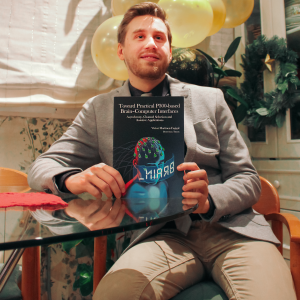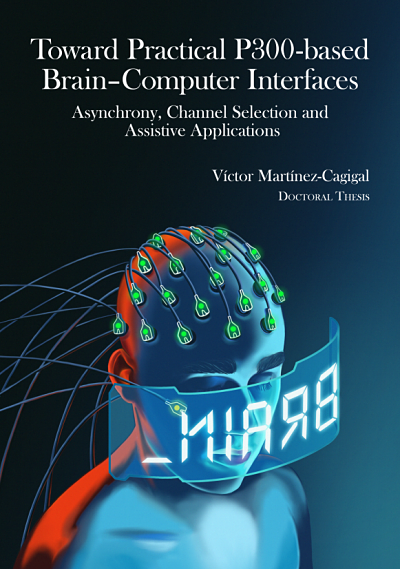Toward Practical p300-based Brain-Computer Interfaces
Asynchrony, channel Selection and Assistive Applications
| Doctorado en Tecnologías de la Información y las Telecomunicaciones |
| Doctor: Víctor Martínez Cagigal |
| Fecha de la lectura: 14/12/2020 |
| Directores: Roberto Hornero Sánchez |
| Tribunal: |
Introduction

For decades, mankind has fantasized about the possibility of controlling devices with our minds. Despite there is still a long way to go to achieve that goal, recent progresses in neuroscience took a step forward and contributed to the development of the first brain–computer interface (BCI) systems. Through the analysis of electroencephalographic (EEG) signals, BCIs are able to decode users' intentions into application commands. Due to its ability to enhance or even replace nervous system outputs, BCIs have emerged as novel assistive technologies that could improve the quality of life of the severely disabled. Nevertheless, these systems currently do not provide the required reliability to take the leap from laboratories to real environments. Among the problems that current BCIs should face to, poor performances, need of supervision and lack of portability and validation with target users stand out.
In this context, the Doctoral Thesis is focused on the development of novel signal processing methodologies and assistive applications that contribute to provide a real use of BCIs by motor-disabled people. From all kinds of BCI control signals, the studies included in this compendium of publications use the P300 evoked potential due to its versatility and reliability.
Development
The contributions of this study are canalized in three different ways. Firstly, two asynchronous algorithms are proposed: a thresholding wrapper approach, and a filter entropy-based approach. The thresholding approach was integrated in two different assistive applications and tested with motor-disabled users, while the entropy-based approach was studied offline with healthy subjects. Secondly, we propose the application of evolutionary single and multi-objective meta-heuristics to select optimal channel sets for each user. We also present a novel multi-objective algorithm especially designed for the BCI framework, the dual-front genetic algorithm (DFGA). They were tested with three public databases that recorded data of healthy subjects from different oddball paradigms. Lastly, we present the design, development and evaluation of two novel asynchronous assistive BCI applications: (i) a web browser, and (ii) a social networking app for smartphones. The web browser is intended to be controlled using a laptop, selecting page links through a node tagging approach via row-col paradigm matrices. The social networking app, by contrast, allows users to control Twitter and Telegram in their smartphones. Both were evaluated with a population of motor-disabled users in order to assess their feasibility in a real setup.
Our findings showed that the integration of an asynchronous management significantly improved the performance in assistive BCIs. Particularly, it was found that control signals are more complex and irregular than non-control ones, allowing a reliable monitoring of users' attention using entropy-based metrics (up to 94.4% accuracy). These outcomes brought to light the need of implementing an asynchronous stage to provide a comprehensive control of the BCI and thus, to support the personal autonomy of the target users. Moreover, results showed that optimal channel sets present a high inter-subject variability, making the channel selection stage essential to optimize the overall performance of each user. In that sense, the balanced combination of deterministic and stochastic strategies of DFGA fostered the overcoming of existing algorithms in terms of performance and convergence. Concerning the assistive applications, results showed that the motor-disabled participants obtained significantly lower accuracies than healthy subjects (web browser: 95.8%, social networking: 92.3%), which states that a validation with target users is crucial to assure the feasibility of BCIs in a real context. Despite this fact, the performances of motor-disabled users were more than enough to claim the viability of both applications (web browser: 84.1%, social networking: 80.6%). Furthermore, participants stated that they could imagine themselves using both applications on their daily basis. We feel that these studies will contribute to move toward a real use of these systems by motor-disable people, aiming at improving their personal autonomy and quality of life.
Ending
This Doctoral Thesis was awarded with a “Cum Laude” distinction by unanimity, as well as with the International Mention after a three-month internship at the Institute of Neural Engineering (INE), at the Graz University of Technology (Graz, Austria).
